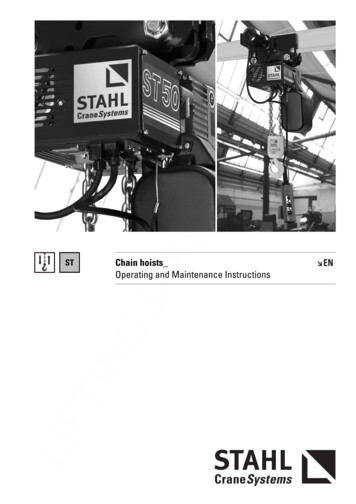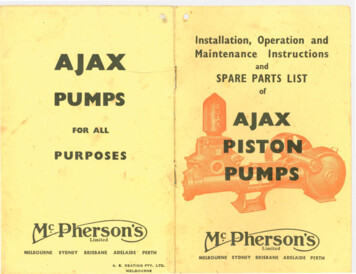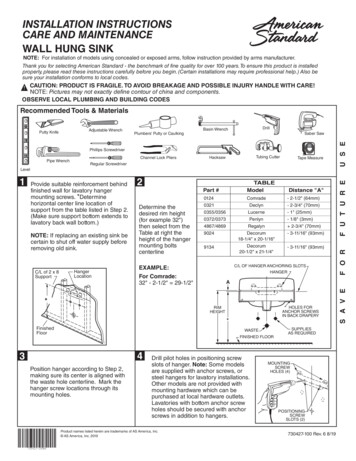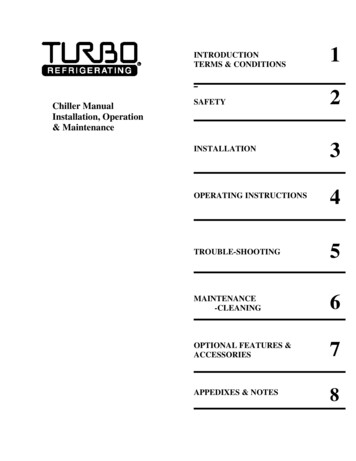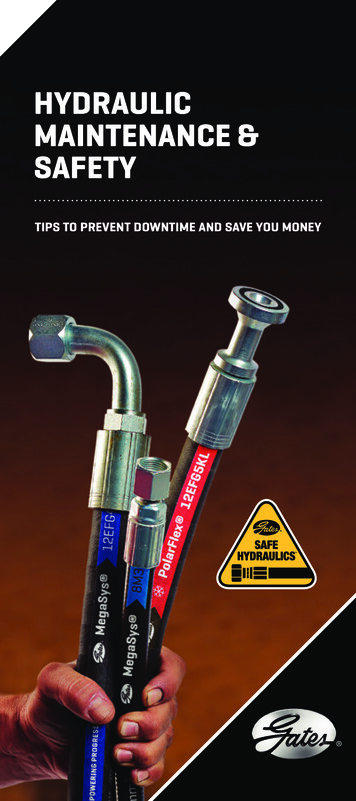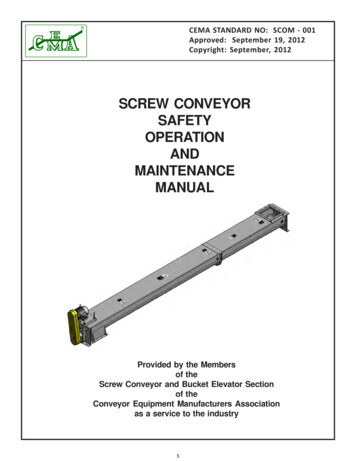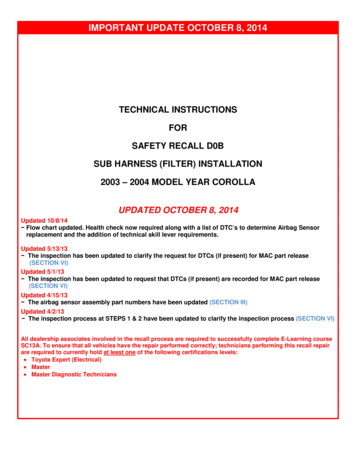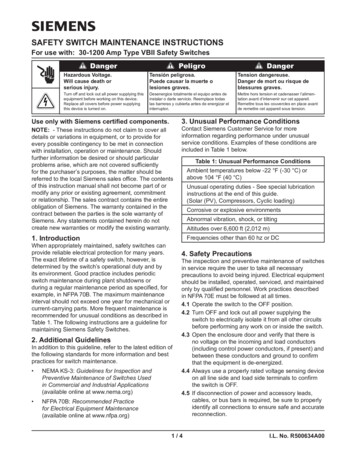
Transcription
sSAFETY SWITCH MAINTENANCE INSTRUCTIONSFor use with: 30-1200 Amp Type VBII Safety SwitchesDangerHazardous Voltage.Will cause death orserious injury.Turn off and lock out all power supplying thisequipment before working on this device.Replace all covers before power supplyingthis device is turned on.PeligroTensión peligrosa.Puede causar la muerte olesiones graves.Desenergice totalmente el equipo antes deinstalar o darle servicio. Reemplace todaslas barreras y cubierta antes de energizar elinterruptor.Use only with Siemens certified components.NOTE: - These instructions do not claim to cover alldetails or variations in equipment, or to provide forevery possible contingency to be met in connectionwith installation, operation or maintenance. Shouldfurther information be desired or should particularproblems arise, which are not covered sufficientlyfor the purchaser’s purposes, the matter should bereferred to the local Siemens sales office. The contentsof this instruction manual shall not become part of ormodify any prior or existing agreement, commitmentor relationship. The sales contract contains the entireobligation of Siemens. The warranty contained in thecontract between the parties is the sole warranty ofSiemens. Any statements contained herein do notcreate new warranties or modify the existing warranty.Contact Siemens Customer Service for moreinformation regarding performance under unusualservice conditions. Examples of these conditions areincluded in Table 1 below.Table 1: Unusual Performance ConditionsAmbient temperatures below -22 F (-30 C) orabove 104 F (40 C)Unusual operating duties - See special lubricationinstructions at the end of this guide.(Solar (PV), Compressors, Cyclic loading)Corrosive or explosive environmentsAbnormal vibration, shock, or tiltingAltitudes over 6,600 ft (2,012 m)Frequencies other than 60 hz or DCWhen appropriately maintained, safety switches canprovide reliable electrical protection for many years.The exact lifetime of a safety switch, however, isdetermined by the switch’s operational duty and byits environment. Good practice includes periodicswitch maintenance during plant shutdowns orduring a regular maintenance period as specified, forexample, in NFPA 70B. The maximum maintenanceinterval should not exceed one year for mechanical orcurrent-carrying parts. More frequent maintenance isrecommended for unusual conditions as described inTable 1. The following instructions are a guideline formaintaining Siemens Safety Switches.4. Safety PrecautionsIn addition to this guideline, refer to the latest edition ofthe following standards for more information and bestpractices for switch maintenance. NEMA KS-3: Guidelines for Inspection andPreventive Maintenance of Switches Usedin Commercial and Industrial Applications(available online at www.nema.org) NFPA 70B: Recommended Practicefor Electrical Equipment Maintenance(available online at www.nfpa.org)Mettre hors tension et cadenasser l’alimentation avant d’intervenir sur cet appareil.Remettre tous les couvercles en place avantde remettre cet appareil sous tension.3. Unusual Performance Conditions1. Introduction2. Additional GuidelinesDangerTension dangereuse.Danger de mort ou risque deblessures graves.The inspection and preventive maintenance of switchesin service require the user to take all necessaryprecautions to avoid being injured. Electrical equipmentshould be installed, operated, serviced, and maintainedonly by qualified personnel. Work practices describedin NFPA 70E must be followed at all times.4.1 Operate the switch to the OFF position.4.2 Turn OFF and lock out all power supplying theswitch to electrically isolate it from all other circuitsbefore performing any work on or inside the switch.4.3 Open the enclosure door and verify that there isno voltage on the incoming and load conductors(including control power conductors, if present) andbetween these conductors and ground to confirmthat the equipment is de-energized.4.4 Always use a properly rated voltage sensing deviceon all line side and load side terminals to confirmthe switch is OFF.4.5 If disconnection of power and accessory leads,cables, or bus bars is required, be sure to properlyidentify all connections to ensure safe and accuratereconnection.1/4I.L. No. R500634A00
sSAFETY SWITCH MAINTENANCE INSTRUCTIONSFor use with: 30-1200 Amp Type VBII Safety SwitchesDangerHazardous Voltage.Will cause death orserious injury.Turn off and lock out all power supplying thisequipment before working on this device.Replace all covers before power supplyingthis device is turned on.PeligroTensión peligrosa.Puede causar la muerte olesiones graves.Desenergice totalmente el equipo antes deinstalar o darle servicio. Reemplace todaslas barreras y cubierta antes de energizar elinterruptor.5. Annual Switch InspectionUnder normal operating conditions, it is recommended toinspect switches at least once a year or after any shortcircuit event. This inspection should only be performedon a properly isolated switch. The inspection shouldinclude the following: Check switch for dust, corrosion, or moisture.Excessive dust, corrosion, or moisture will shortenthe life of the switch and may indicate a different typeof enclosure is required for the application. Check switch bases for cracks. The integrity ofthe base is important in withstanding the stressesimposed during operation. The switch should bereplaced if cracks are found. Check switch for overheating. Overheating can beindicated by discoloration or cracks of the switchbases, discoloration or flaking of external metalparts, or melting or blistering of adjacent wireinsulation. The switch should be replaced if any signof overheating is found. Check all electrical connections to the switch tobe certain that such connections are clean andsecure. Loose or contaminated connections increaseelectrical resistance, which can damage insulationand conductors and interfere with proper switchoperation. Increased electrical resistance causesoverheating of a connection. Check switch grease. Safety switches are properlylubricated at the factory. Periodic cleaning andlubrication may be required depending on theamount of usage and the operating conditions of theswitch. Check switch for missing hardware. For switches with cover gasketing and sealant,check to ensure that the gasket has not separatedfrom the cover. Check switch for water damage. If the switch showssigns of water damage, it should be replaced.6. Clean SwitchWith the switch still properly isolated from the rest of thecircuit, loose hardware, dust, debris, and moisture shouldbe removed from the inside of enclosure. Wipe with aclean, dry, lint-free cloth or soft brush.DangerTension dangereuse.Danger de mort ou risque deblessures graves.Mettre hors tension et cadenasser l’alimentation avant d’intervenir sur cet appareil.Remettre tous les couvercles en place avantde remettre cet appareil sous tension.If the amount of dust or debris is excessive, steps shouldbe taken to eliminate the source of the contaminationor to provide an appropriate enclosure that will protectagainst the future entry of contaminants.NOTE—Commercial cleaners and lubricants may attackand damage the plastic insulating materials of the switch.Such cleaners should not be used.7. Tighten ConnectionsVerify that all wire connection torques conform to thevalues provided in the Terminal and Wire InformationTable found on the interior label of the switch. Do notexceed the torque values on the interior label. Overtorqued connections can lead to the switch overheating.8. Lubricate ComponentsThe lubricant applied at the factory is intended to last thelife of the switch. Additional lubrication may be appliedif required by the usage or operating conditions of theswitch. Line and Load contact grease: Rheolube 716CP Mechanism grease: Lubriplate Aero Fuse clip grease: Nyogel 760GONLY use the approved lubricants inthe indicated locations listed. Other lubricants maynot be suitable for electrical applications and could be adetriment to the performance of the switch.9. Cycle SwitchBefore restoring power to the switch, close the door andoperate the switch ON and OFF five times. The switchhandle should operate smoothly without binding.10. To Re-Energize SwitchWith the switch handle in the OFF position:10.1 Reconnect any cables or accessory leadsdisconnected in step 4, Safety Precautions.10.2 Replace all covers and shields.10.3 Close and latch the door.10.4 Turn OFF all downstream loads.10.5 Turn ON power supplying the switch.10.6 Turn ON the switch.10.7 Turn ON all downstream loads.2/4I.L. No. R500634A00
sSAFETY SWITCH MAINTENANCE INSTRUCTIONSFor use with: 30-1200 Amp Type VBII Safety SwitchesDangerHazardous Voltage.Will cause death orserious injury.Turn off and lock out all power supplying thisequipment before working on this device.Replace all covers before power supplyingthis device is turned on.PeligroDangerTensión peligrosa.Puede causar la muerte olesiones graves.Desenergice totalmente el equipo antes deinstalar o darle servicio. Reemplace todaslas barreras y cubierta antes de energizar elinterruptor.Special Lubrication Instructions forUnusual Operating DutiesTension dangereuse.Danger de mort ou risque deblessures graves.Mettre hors tension et cadenasser l’alimentation avant d’intervenir sur cet appareil.Remettre tous les couvercles en place avantde remettre cet appareil sous tension.4. Clean and Lubricate Fuse Clips1. IntroductionSafety Switches used in some operating duties requireadditional maintenance or more frequent inspections toensure the full life of the product is achieved. Switchesused in solar (PV), compressor, or other cyclic loadingconditions are examples of these unusual operatingduties. In addition to the maintenance guidelines listedabove, these switches may also require lubrication of thefuse connections.4.1. Clean the fuse clips with a clean, dry, lint-free cloth.4.2. Using a small brush or putty knife, apply a thin coatof Nyogel 760G across the entire inside surface ofboth sides the fuse clip as shown below.2. Safety PrecautionsThe inspection and preventive maintenance of switchesin service require the user to take all necessaryprecautions to avoid being injured. Electrical equipmentshould be installed, operated, serviced, and maintainedonly by qualified personnel. Work practices described inNFPA 70E must be followed at all times.2.1 Operate the switch to the OFF position.2.2 Turn OFF and lock out all power supplying the switchto electrically isolate it from all other circuits beforeperforming any work on or inside the switch.2.3 Open the enclosure door and verify that there isno voltage on the incoming and load conductors(including control power conductors, if present) andbetween these conductors and ground to confirmthat the equipment is de-energized.2.4 Always use a properly rated voltage sensing deviceon all line side and load side terminals to confirm theswitch is OFF.2.5 If disconnection of power and accessory leads,cables, or bus bars is required, be sure to properlyidentify all connections to ensure safe and accuratereconnection.3. Inspection3.1. Remove the installed fuses.3.2. Visually check the fuse connections for evidence ofoverheating or arcing on the fuse clips or mountingarrangements for the fuse.3.3. If the connecting surfaces show evidence ofoverheating, the affected parts of the switch (linebase and/or load base) and any discolored fusesshould be replaced.3/430-60AFerrule TypeFuse ClipApply Nyogel760G to shadedarea of fuse clip100-200A Blade Type Fuse ClipApply Nyogel760G to shadedarea of fuse clipI.L. No. R500634A00
sSAFETY SWITCH MAINTENANCE INSTRUCTIONSFor use with: 30-1200 Amp Type VBII Safety SwitchesDangerHazardous Voltage.Will cause death orserious injury.Turn off and lock out all power supplying thisequipment before working on this device.Replace all covers before power supplyingthis device is turned on.PeligroTensión peligrosa.Puede causar la muerte olesiones graves.Desenergice totalmente el equipo antes deinstalar o darle servicio. Reemplace todaslas barreras y cubierta antes de energizar elinterruptor.DangerTension dangereuse.Danger de mort ou risque deblessures graves.Mettre hors tension et cadenasser l’alimentation avant d’intervenir sur cet appareil.Remettre tous les couvercles en place avantde remettre cet appareil sous tension.Apply Nyogel760G to shadedarea of fuse clip400-600A Fuse ClipApply Nyogel760G to shadedarea of fuse clipspring800-1200A Bolt-On Type Fuse ClipApply thin coatof Nyogel 760Gto shaded areaof fuse5. To Re-Energize SwitchWith the switch handle in the OFF position:15.1 Reconnect any cables or accessory leadsdisconnected in step 2, Safety Precautions.15.2 Replace all covers and shields.15.3 Close and latch the door.15.4 Turn OFF all downstream loads.15.5 Turn ON power supplying the switch.15.6 Turn ON the switch.15.7 Turn ON all downstream loads.Technical Support: Toll Free: 1-800-241-4453Subject to change without prior notice.Siemens Industry Inc., Norcross, GA 30092 Siemens Industry Inc. 2019Internet: www.usa.siemens.com/powerdistribution4/4I.L. No. R500634A00
sINSTRUCTIONS D’ENTRETIEN DES INTERRUPTEURS DE SÉCURITÉÀ utiliser avec : Interrupteurs de sécurité de type VBII de 30 à 1200 ADangerHazardous Voltage.Will cause death orserious injury.Turn off and lock out all power supplying thisequipment before working on this device.Replace all covers before power supplyingthis device is turned on.PeligroTensión peligrosa.Puede causar la muerte olesiones graves.Desenergice totalmente el equipo antes deinstalar o darle servicio. Reemplace todaslas barreras y cubierta antes de energizar elinterruptor.Utiliser uniquement avec descomposantes certifiées de Siemens.DangerTension dangereuse.Danger de mort ou risque deblessures graves.Mettre hors tension et cadenasser l’alimentation avant d’intervenir sur cet appareil.Remettre tous les couvercles en place avantde remettre cet appareil sous tension.3. Condit
example, in NFPA 70B. The maximum maintenance interval should not exceed one year for mechanical or current-carrying parts. More frequent maintenance is recommended for unusual conditions as described in Table 1. The following instructions are a guideline for maintaining Siemens Safety Switches. 2. Additional Guidelines In addition to this guideline, refer to the latest edition of the .
